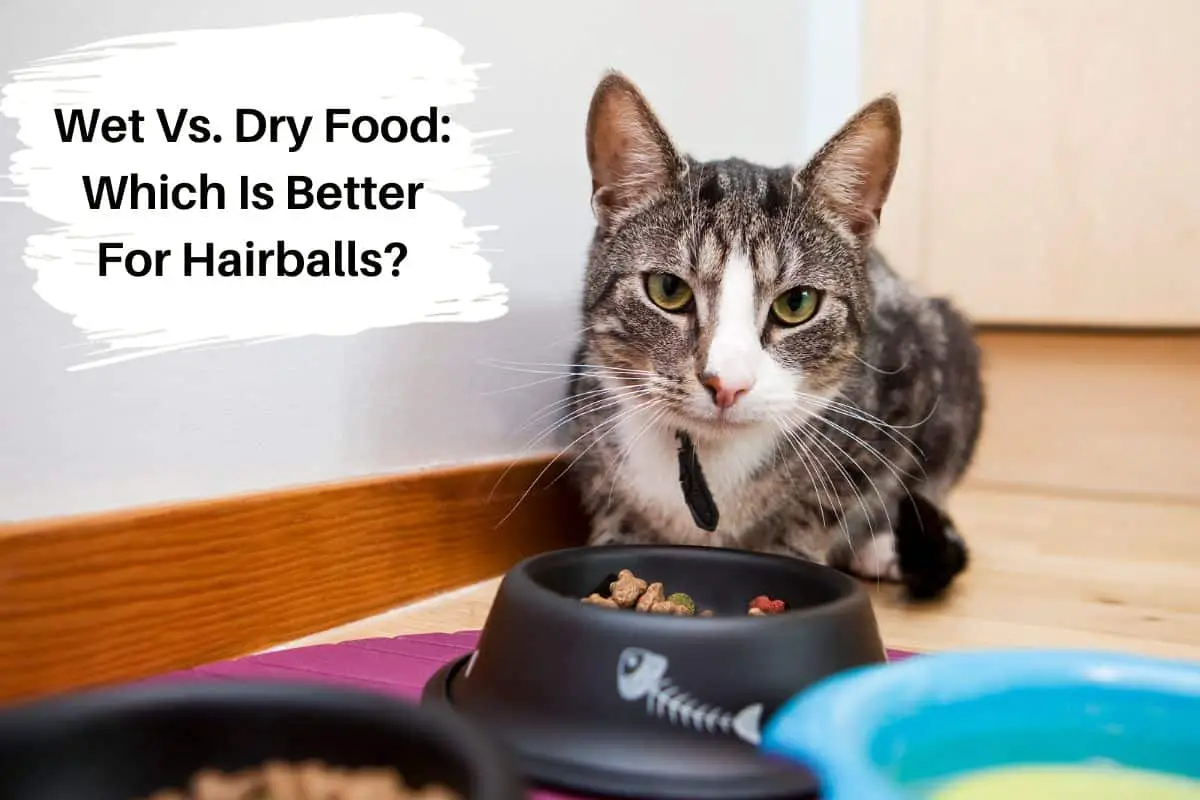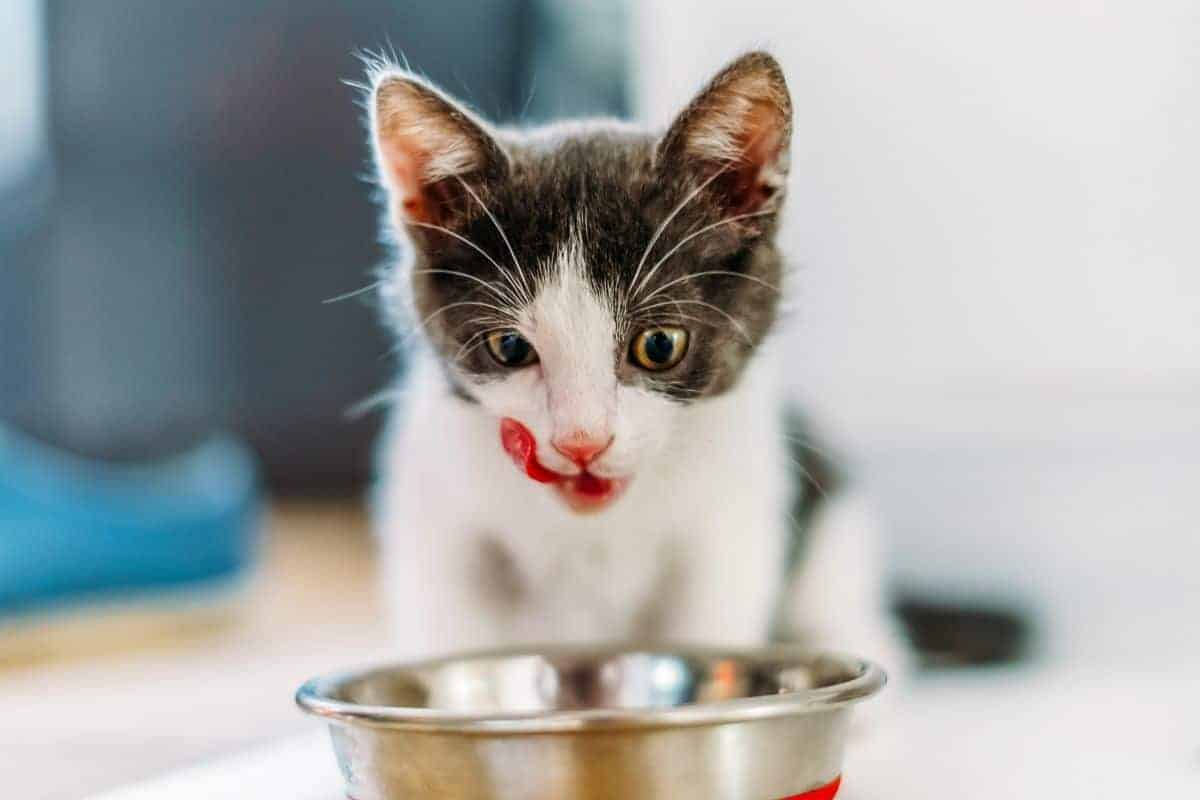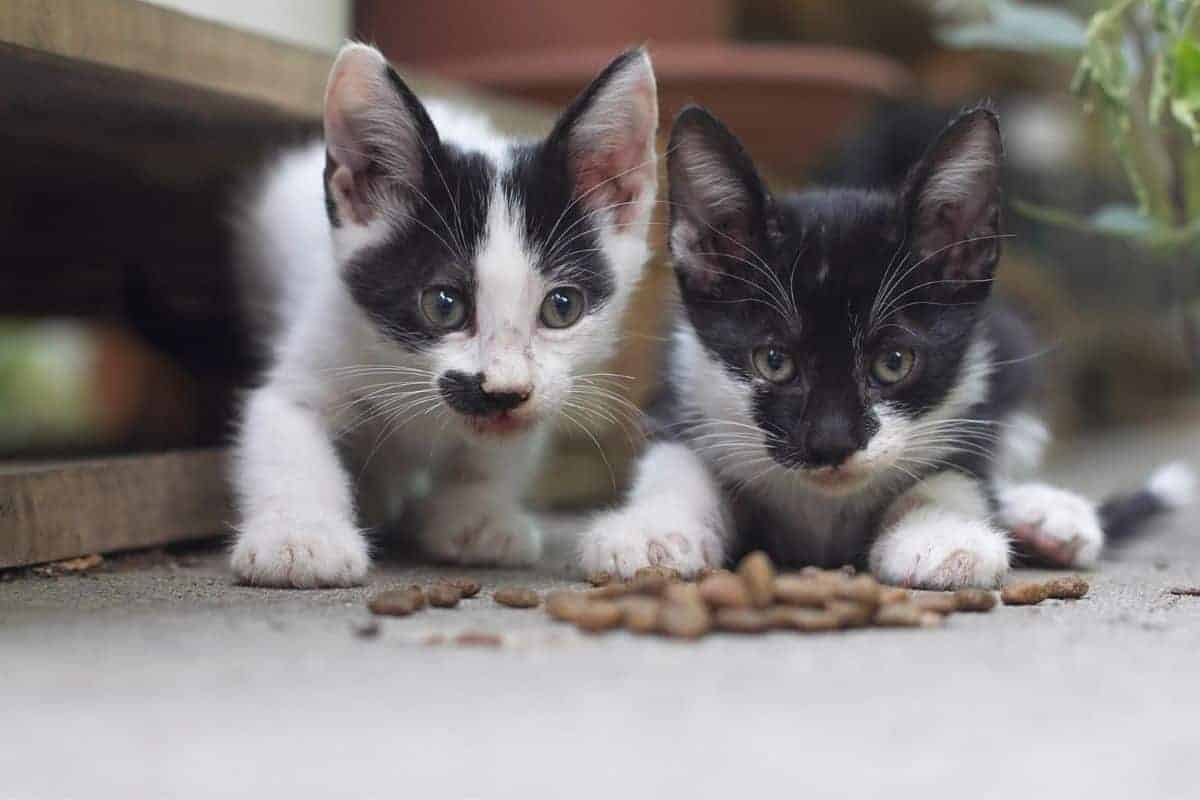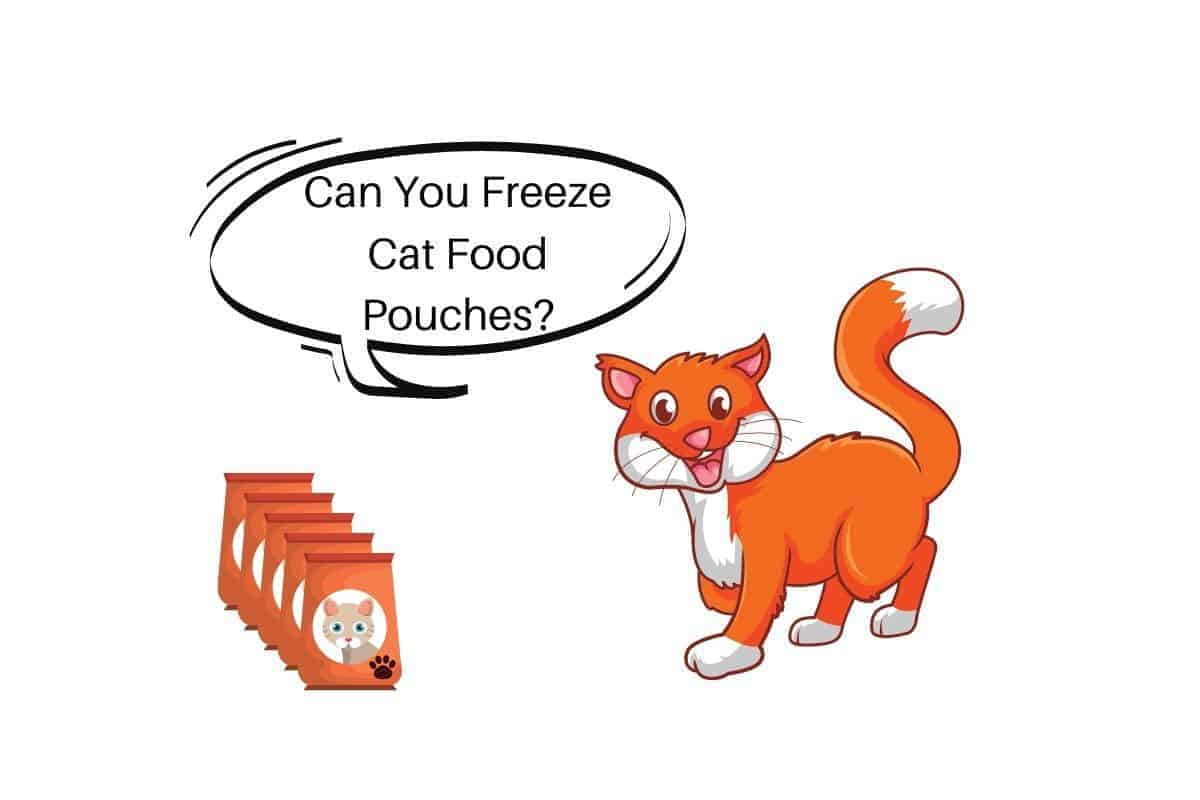If you have owned cats, you will be familiar with the retching and vomiting that results in a nasty wet mass of hairball deposited somewhere in the house – usually on a hard-to-clean sofa or carpet! Some cats seem to have more hairballs than others. Owners often find the retching and vomiting disturbing. Pet food companies responded to the problem by developing cat foods that assist with removing and preventing hairballs in cats. Some are wet cat food, and some are dry. Is there any difference between the types, and which one is better?
Both wet and dry hairball food contain fibers to help entrap the hairs in the gastrointestinal system. The fibers are moved through the digestive system and eliminated. Wet hairball food has the advantage of being high in moisture which activates the vegetable fibers and softens the hair.
This article will examine the different kinds of cat hairball foods available and look at the components that help remove hairballs. It will look at if there is an advantage to dry or wet foods. Coat and skin health are important to reduce shedding.
What Are Hairballs And Why Do Cats Get Them?
Cats are fastidious about their cleanliness. They groom themselves by licking their coats all over. A cat’s tongue has backward-facing barbs called papillae. Papillae have sharp edges made of keratin. Human finger and toe-nails and horns on animals are all made of keratin. This explains why a cat’s tongue feels so rough. The papillae can strip the meat off bones just by the cat licking the bone. Papillae are also very useful for grooming. Any loose hair gets caught in the papillae. The cat cannot spit out the hair because the barbs face backward, and so it is swallowed. Hairballs are called trichobezoars.
How Often Do Cats Get Hairballs?
Cats can get hairballs up to once or even twice a week. Some cats are over-enthusiastic groomers, and these will be the cats that get hairballs twice a week. In the case of a cat that is grooming too much, it would be best to try and reduce the amount of grooming. This can be done by distracting the cat with toys, petting, interactive games, toys that contain catnip or valerian, or training the cat to do tricks.
Do All Cats Get Hairballs?
Not all cats get hairballs. About ten percent of shorthaired cats get hairballs regularly. The number doubles for long-haired cats such as Persians and Maine Coons. The longer coats result in twenty percent of long-haired cats getting hairballs regularly. It makes sense that long hairs are harder to pass through the digestive tract and form hairballs that are vomited out.
Where Do Hairballs Occur In The Gastrointestinal Tract?
Trichobezoars or hairballs can occur at any place in the gastrointestinal tract of cats. Sometimes they can line the esophagus, and sometimes they form a ball in the stomach. Hairballs that are vomited up are from the esophagus or the stomach. They rarely come out shaped like a ball and usually look more like a cigar in shape. The cigar shape allows the hairballs to move back up through the esophagus to be expelled.
Sometimes a hairball can become hardened because they accumulate stomach debris and cannot be vomited out. At other times the hairball can move from the stomach into the intestine. The problem with hairballs in the intestine is that intestines have many loops and narrowed areas resulting in a hairball becoming lodged. In uncomplicated cases, cats can pass the hair out with feces. In cases where the hairball has formed a hard mass or is stuck in the intestines, immediate veterinary attention is needed. Obstructions in the gastrointestinal tract are very painful.
How Do I Know If My Cat Has a Hairball Blockage?
A cat with a blockage from a hairball or a hairball that is too large in the stomach will be extremely uncomfortable. The cat will appear distressed, may retch, will meow, and be restless. He or she will not want to eat. There may be constipation or diarrhea, and the cat will be lethargic. The mucous membranes will become pale or purplish-red if the hairball is forming a complete obstruction. To check the mucous membranes, lift the lips and look at the gums or pull down the eyelids to look at the membranes inside the eyelids. Pale mucous membranes indicate a cat going into shock. The dark purple-blue-red membranes indicate a very urgent problem. If the membranes are dark, the cat has been in shock for some time, and the tissues are low on oxygen. In both cases, take your cat to the veterinarian urgently as gastrointestinal obstruction can be fatal.
Prevention is Better Than Cure For Hairballs.
It is better to prevent hairball development if you can. Cat food companies have addressed the problem by developing hairball prevention foods. Grooming your cat regularly can help to prevent the formation of hairballs. Long-haired cats should be groomed daily if they are having consistent problems with hairballs. Shorthaired cats with hairball issues can be groomed two to three times a week. If you can spend even ten minutes a day grooming your cat, you can remove most of the loose hair. Grooming allows you to keep control of the coat and spend valuable time with your cat.
Hairball Remedy Cat Foods.
Various brands of cat food have developed hairball remedy cat foods to assist cats with dispelling the hair. They can address a hairball problem that has already formed or loose hairs present in the stomach. The foods came in both dry and wet food varieties. The basic premise behind hairball prevention is that the foods contain insoluble fibers that trap the hairs and move them out of the digestive tract with the feces. If the hair is already in a hardened ball, the hairball food cannot remove it. A hardened hairball will require alternative methods to dislodge it and perhaps even surgery.
Hairball Foods
Many of the major cat food brands produce dry and wet hairball foods. There is usually a two-pronged treatment to minimize the occurrence of hairballs. The first is to remove the hair and the second is to improve coat and skin health to reduce shedding. The foods contain different types of insoluble fibers to remove the hairs. Omega oils, prebiotics, probiotics, and various beneficial skin vitamins are added to improve coat and skin quality. The different insoluble fibers are:
Vegetables and fruit may be used to provide the vegetable fibers. Beet and pumpkin are popular vegetables to add to increase fiber content.
Cellulose is the insoluble vegetable fibers from the cell walls of a plant. It absorbs water and forms a gel around the fibers. Some brands do not specify which plant matter provides the cellulose in the food.
Psyllium is also known as ispaghula and is made from the seed husks of the Plantago Ovato plant. The husks are rich in insoluble fibers. The fibers absorb up to thirty times their weight in water and produce mucilage. Mucilage is a slimy gel-like substance around the fibers that facilitates the entrapment of the hairs and also stimulates peristalsis in the gastrointestinal tract.
Dry Hairball Cat Foods
Royal Canin has an Hairball Care Dry Cat Food that contains psyllium.
Hill’s Science Diet Dry Cat Food, Light Adult, Hairball Control that has cellulose from wheat, soy, and corn to facilitate the removal of hairballs.
Blue Buffalo Cat Food For Hairballs and Weight Control contains fruit and vegetables that provide the insoluble fibers to remove hair and increase peristalsis. It also incorporates omega oils.
Iams Proactive Health Hairball Care includes beet pulp and omega oils.
Purina One Hairball Formula uses wheat and corn insoluble fibers together with omega oils in their food.
Feline Greenies Smart Bites Hairball Control are treats that contain insoluble fibers for the removal of hair. They do not replace the cat’s regular food and are fed as an additional treat that doubles up to control hairballs. the hairball treats can be used as a reward when you train a cat to do tricks or play with an interactive toy to distract the cat from excessive grooming.
Wet Hairball Cat Foods.
Wet cat food refers to canned cat food. The moisture content is much higher in canned foods. Cats are not big drinkers, and some cats are worse at drinking sufficient quantities than others. Insufficient water consumption can lead to constipation and other issues. Thus food with high moisture content is beneficial.
Hill’s Science Diet Hairball Control Adult uses vegetables to provide the necessary fiber. It comes in different flavors, including chicken, turkey, and pork meat.
Purina One Chicken and Rice Entrée contain wheat, corn, and rice fibers.
Some wet foods do not state that they are specifically for hairballs. Look at the ingredients on any canned cat food. If it contains vegetables or psyllium, then it is suitable for use to prevent hairballs. Some examples of food that is not advertised for hairballs but can help reduce hairballs are:
Nom-nom Fresh Food is a company that produces fresh foods for cats. It is not bought through retail stores but is instead delivered to you. It contains very high-quality protein (66,6%) and vegetables. Spinach and carrots provide beneficial, hairball-control vegetable fibers.
Instinct Original Grain-Free Pate is a high protein, grain-free wet food that includes fibers from vegetables that assist with hair removal.
Wet Vs. Dry Cat Food: Which Is Better For Hairballs.
In dry cat foods, the insoluble fibers are in a dried-out form. They must first absorb water before they can be of use to entrap hair and increase peristalsis. If the cat does not take in enough water, the fibers will not function efficiently. Dry food in a cat that drinks insufficiently leads to constipation and other gastric problems that can worsen the hairball problem. Wet or canned foods contain high quantities of moisture – 75- 78 %. This means that the cat does not need to consume water for the fibers to begin working. As it is difficult to force cats to drink, wet food may be more advantageous to remove hairs and reduce hairball formation. The high water content in canned foods will also help soften existing hairballs and aid in expulsion.
Supplements To Improve Digestion And Reduce Hairballs
Sometimes veterinarians recommend additional supplements to sprinkle on the cat’s food to improve the cat’s peristalsis and entrap hairs. These supplements have a high insoluble fiber content. They can be used for cats that have both diarrhea and constipation. The insoluble fibers form a bulky mass that helps to regulate digestion.
Raw Paws Pet Organic Pure Pumpkin For Cats is a powdered organic pumpkin that provides fibers and antioxidants.
Psyllium Husk Powder can be bought at many pharmacies and health shops.
Can A Cat Have Hairball Food Every Day?
Cats are obligate carnivores. This term refers to the fact that cats are designed to obtain all their nutrients from animal products. They need a high protein diet. Fifty to fifty-five percent protein is optimal with forty to forty-three percent fat. Cats can go for long periods without drinking water if they eat a high protein wet diet. Their moisture is obtained from the food. A cat’s digestive tract is not designed to digest carbohydrates. It does not contain the enzymes and fermentation processes to digest vegetable fibers. In the wild, the cat species consume two to three percent of animal fibers such as tendons, fur, feathers, and bones from their prey. Vegetable fibers are sometimes eaten when they occur in the stomach contents of prey. Carbohydrates and fibers should not form more than three percent of the cat’s diet. Eating a high fiber diet permanently could compromise the absorption of protein in the cat’s gut, resulting in malnourishment.
Increasing Coat Health To Reduce Hairballs.
If the skin and coat are healthy, there will be less hair loss. Cat foods that contain omega oils three and six contribute to improving the quality of the cat’s skin and coat. Prebiotics and probiotics aid in preventing fungal and yeast infections. Fungal and yeast infections cause hair to be damaged and loose in the follicle, resulting in increased hair loss. The prebiotics and probiotics enhance digestion which enables the gut to absorb nutrients optimally. Vitamin E, vitamin B, zinc, and biotin are also essential in maintaining good skin and coat health.
Eliminating Stubborn Hairballs
Sometimes veterinarians recommend giving a little oil or Vaseline to dislodge a problematic hairball in the stomach or esophagus. The oil or Vaseline coats the hairball and allows it to move easily and be expelled either with the feces or by vomiting. These techniques cannot be used continuously as they compromise the absorption of nutrients. Liquid paraffin, sometimes called mineral oil, should not be given by itself. It is very light and tasteless, and there is a risk of the cat aspirating it (inhaling it into the lungs).
Conclusion
Both shorthaired and long-haired cats get hairballs. Not every cat gets hairballs regularly. Certain individuals are more prone to developing hairballs. Cat food brands have developed both dry and wet foods to combat hairballs. Wet foods have an advantage in that the moisture is already present in the food. Dry foods rely on the cat drinking water for them to function optimally. Cats should not be fed a high fiber hairball diet as their permanent diet. It will result in dietary deficiencies as the cat will not be able to absorb the protein needed.
Skin and coat health should be addressed to reduce the amount of shedding. Cats that have a behavioral issue and groom obsessively should be managed with behavioral techniques to correct the behavior. If the cat owner cannot alter the behavior, a cat behaviorist should be consulted. The cat owner can reduce the incidence of hairballs by grooming the cat regularly. This is especially important for long-haired cat breeds. The time spent grooming the cat may also help to reduce abnormal self-grooming as it also provides stimulation for the cat.
Sources
- Beynen, A. 2015. Feline Hairball Control By Dietary Cellulose.
- Tudor, K. 2012. Do Cats Need Fiber In Their Diets? PetMD. Do Cats Need Fiber in Their Diet? | PetMD







